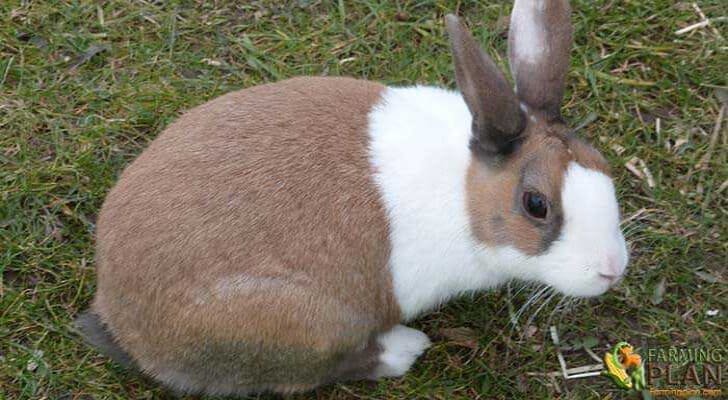The Dutch rabbit your name may give rise to the misconception about your place of origin. The Dutch rabbit is native to England. Hence its name, in the year 1864 and inherit a great part of the color of its ancestors, the race Petit Brabançon. It is probably one of the oldest breeds that have become domestic.
Not only as pet companions but, sadly, to perform shows. In the ’60s, the creation of a Dutch tricolor was thought to be a cross between a Harlequin and a Dutchman. Later a Dutch version of Harlequin color was developed, probably produced from the Dutch tortoise.

Characteristics of Dutch Rabbit
The Dutch rabbit is easy to recognize for its peculiar spots. Because they delimit parts of its body and give it a very endearing look, with a very characteristic color pattern. Physically, the Dutch rabbit has certain characteristics that stand out such as compact body and the coloration of its hair: black, chocolate, steel gray, pale gray, grayish-brown or yellow. You May Also Like To Read San Juan Rabbit
Its coat is abundant, short and very bright. But above all, because they always have a white strip that divides their body in two. It has medium ears always pointed, quite smaller than those of the rabbit Belier, also has a lot of hair. This breed has bulging eyes that give it great expressiveness. Its weight does not exceed two kilos, which makes it an animal quite comfortable for the home.
In captivity, with good care, they can live between 8 and 10 years. Many of these rabbits have around their eyes hairs of a color that almost looks like paint. But in addition to its peculiar characteristics, this rabbit is known for its docility, its affectionate and quiet personality and its small size. Traits that make it the perfect mascot for many people who seek the company of an animal but who, for space and time, can not afford to have a dog or a cat.
Food
The Dutch rabbit its diet should consist of dry feed contains green plants, cereals, seeds, dehydrated vegetables, and vitamins. Depending on the size of the rabbit the breeder should give 3 to 4 tablespoons of dry feed daily. In the diet of this breed, the breeders should always include juicy vegetables, such as carrots, and green plants such as dandelion and parsley.
The pieces of fruit tree branches are an excellent material for gnawing. It should be fed at the same time and twice daily, in the morning and in the afternoon. In addition, it should be given dry food in the morning and cool in the afternoon. You May Also Like To Read Himalayan Rabbit
In terms of food, the rabbit must have plenty of freshwaters, which we must change daily and have clean. The breeder can also find food prepared with all the specific nutrients for the rabbit. Something that must be taken into account is that if there are remains of one day to another the breeder must eliminate them because they lose their properties.
Usage
The Dutch rabbit is an ideal pet, especially for families with children. Both because of its adorable appearance and docile and affectionate character as by the simplicity of the care it requires. Rabbits of this type adapt well to your new home, so we will not have to worry excessively beyond offering you space and the attention you need. You May Also Like To Read Lilac Rabbit
Physical Care
One of the aspects that the breeder must pay attention to if we have a Dutch rabbit is the care of his stomach. It is very common for them to form hairballs (just like the felines). What can cause intestinal obstructions; Hence the importance of combing them frequently.
Special Feature
Most animal lovers choose this type of pet for their home is because it is an animal with an excellent personality and an affordable size for any apartment or flat. Although the Dutch do not respond to a race of dwarf rabbits, it does stand out for its small size: in its adult stage usually, does not weigh more than 2 kilos.
As a curiosity, the temperament of the males is more docile than in the females, which are much more independent. These rabbits are tremendously clean. They groom themselves almost as often as a cat. They are constantly cleaning their fur, so it is very advisable to brush them frequently, especially in times of change. One important thing about these rabbits is that they are intelligent.
Rabbit Profile
| Rabbit name | Dutch Rabbit |
| Other Name | Any |
| Rabbit Purpose | As a pet, and to perform a show |
| Coat color | Black, chocolate, steel gray, pale gray, grayish-brown or yellow. |
| Weight | 2 Kg. |
| Climate Tolerance | Warm climates |
| Country of Origin | England |
Conclusion
The Dutch rabbit, also known as Hollander or Brabander is easy to get identifiable by its characteristic color pattern and was once the most popular of all rabbit breeds. However, after dwarf rabbits were developed, the popularity of the Dutch rabbit dwindled. This guide should have helped you identify what makes a Dutch Rabbit different from other types of rabbits so that you can find one for your home! Good luck in finding your new pet!
As a References: Wikipedia


